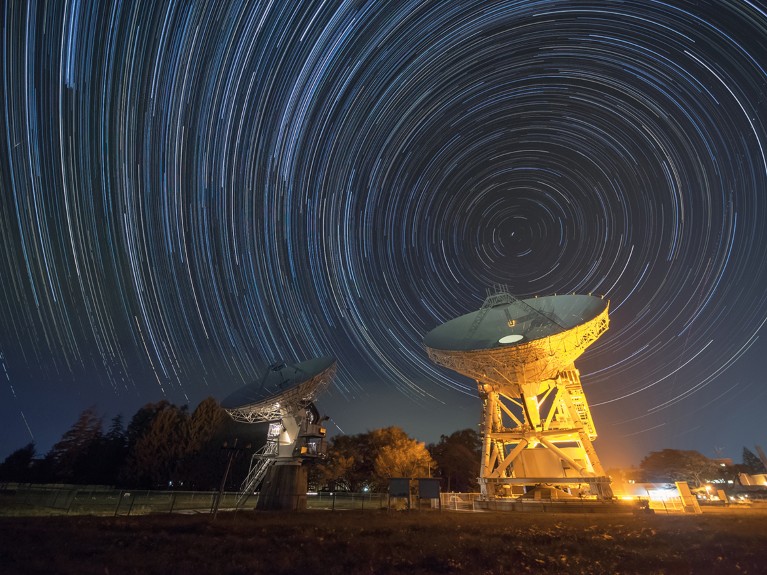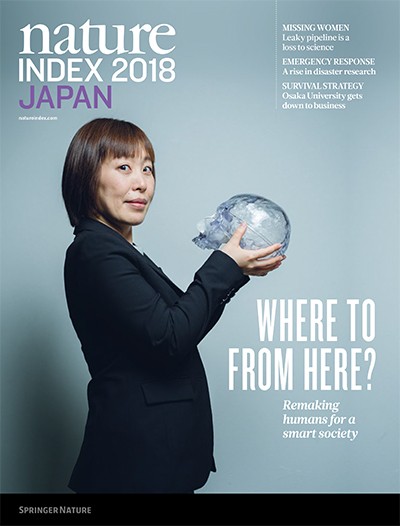
The sky above the VERA Mizusawa Station radio telescope, following the motion of stars. Japan has a strong astronomy research output.Credit: National Astronomical Observatory of Japan
The Japanese government points to the country’s achievements in robotics, sensor devices, supercomputers, and network and transport infrastructure as key to achieving its goal of becoming a “super-smart society”, dubbed Society 5.0.
The five-year plan in effect since April 2016 is for a high-tech world in which cyberspace and real space converge, powered by the Internet of Things (IoT), big data, and artificial intelligence (AI). But analysts caution that Japan faces big challenges in enabling areas of research that have been relatively neglected. The country’s share of global articles in the Scopus database has fallen in every scientific field in the past ten years. Between 2000 and 2017, the global share of papers in computer science, engineering and materials science declined by around 60% each.
Japan’s investments in supporting fields such as information and communications technology have not kept pace with other advanced countries, says Hiroshi Nagano, a lecturer in science and technology policy at the National Graduate Institute for Policy Studies (GRIPS) in Tokyo. This shows in the small contribution of computer science papers (4.4%) to Japan’s overall Scopus output in 2017.
A 2016 World Economic Forum survey ranked Japan 10th in a list of countries according to their use of technology to increase competitiveness and well-being, behind states including Switzerland, Israel, Singapore, and the United States.
Human resources
Building a super-smart society will also require significant investment to build skills among young people who currently do not regard science as an attractive career.
“The demand for technology skills is enormous and cannot be filled by shrinking numbers of young graduates,” says Martin Schulz, senior research fellow at Fujitsu Research Institute.
A 2016 Ministry of Economy, Trade and Industry survey warns of a shortfall of 48,000 IT professionals by 2020.
The government white paper highlights the Ministry of Education, Culture, Sports, Science and Technology’s efforts to nurture more professionals including AI engineers, data scientists, cybersecurity experts and entrepreneurs.
One example is the Advanced Integrated Intelligence Platform Project, a learning programme launched in 2016 with a 5.4 billion yen (US$50 million) budget, which aims to impart the latest research techniques in AI in cooperation with institutes such as RIKEN, the Institute of Statistical Mathematics and the National Institute of Informatics.
Schulz insists that plugging the skills gap will require major corporate investment, which remains scarce, particularly among smaller companies. He points to areas such as telecommunications, smart cities and logistics in which Japan can build on strengths to realize a super-smart society.
Medicine and astronomy
In 2017, the natural science subject with the largest share of the country’s output in Scopus was medicine, followed by biochemistry, then physics and astronomy.
Nagayasu Toyoda, president of Suzuka University of Medical Science in Suzuka City, says that Japan’s output of papers in medicine has risen because there are more doctors available to do research. University hospitals have managed to boost their income and hire, despite budget cuts. A 2016 survey by the Ministry of Health, Labour and Welfare shows that the number of medical doctors in Japan increased to 304,759 from 296,845 in 2014.
Astronomy has been helped by the construction of an enormous digital camera on the Subaru Telescope on Mauna Kea in Hawaii.
In 2013, the Hyper Suprime-Cam was switched on, and by 2016, Japanese researchers had used it to identify a small galaxy orbiting the Milky Way.
Masahiko Hayashi, director general of the National Astronomical Observatory of Japan, attributes Japan’s impressive astronomy output to its involvement in successful observatories such as Subaru and the Atacama Large Millimeter Array.
Hayashi also recognizes the work of the Kavli Institute for the Physics and Mathematics of the Universe. It was established by the government as one of nine centres of excellence for interdisciplinary research under the World Premier International Research Center Initiative, which in 2018 will fund 11 centres at a cost of 60 billion yen ($US560 million).


 Stalled ambition
Stalled ambition
 Resistance to reform
Resistance to reform
 Relative gain
Relative gain
 Calling rikejo
Calling rikejo
 Partners in discovery
Partners in discovery
 Pillars of a smart society
Pillars of a smart society
 Facing down disaster
Facing down disaster
 Short-term generation
Short-term generation
 Access granted
Access granted
 Noble halls of discovery
Noble halls of discovery
 A guide to the Nature Index
A guide to the Nature Index






